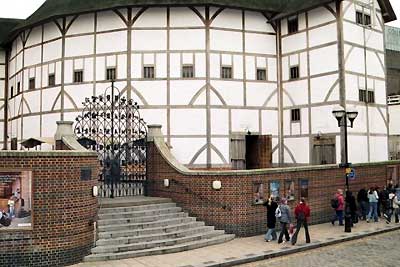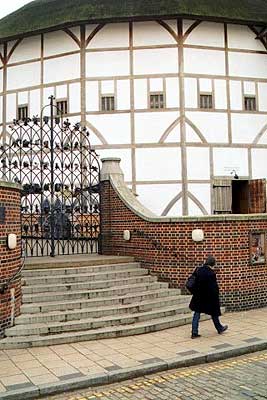Back at Shakespeare’s Globe
 The recreated Globe Theater represents what scholars have pieced together from their research and is only a best guess for what the original theater looked like. No plans or construction drawings of the original have survived. The first two incarnations were destroyed: the first in a fire in 1613, and the second in a demolition in 1644 to make way for tenements. The lime plaster, oak beams and water reed thatch of this latest incarnation sit incongruously among the modern glass and steel buildings of London’s gentrifying Bankside. The beams, which were cut from green oak, even now continue to push and pull against each other as they cure. Our guide explains how London’s theaters were built outside city limits on the south bank of the Thames River since their activities were deemed on the outskirts of propriety. You could likewise indulge in other activities otherwise frowned upon on the other side of the river.
The recreated Globe Theater represents what scholars have pieced together from their research and is only a best guess for what the original theater looked like. No plans or construction drawings of the original have survived. The first two incarnations were destroyed: the first in a fire in 1613, and the second in a demolition in 1644 to make way for tenements. The lime plaster, oak beams and water reed thatch of this latest incarnation sit incongruously among the modern glass and steel buildings of London’s gentrifying Bankside. The beams, which were cut from green oak, even now continue to push and pull against each other as they cure. Our guide explains how London’s theaters were built outside city limits on the south bank of the Thames River since their activities were deemed on the outskirts of propriety. You could likewise indulge in other activities otherwise frowned upon on the other side of the river.
Back when I was a Zurich-based banker, I used to frequent London when my wife was a financial professional, then student in the city. The Globe was not open then. And no, Shakespeare in Love was not filmed here. The theater has seen its resurrection due in large part to an American actor, director and producer named Sam Wanamaker. As a young man in 1949, Wanamaker went hunting for the theater all over Bankside with a taxi driver in tow, only to find a plaque on a brewery wall where the theater once stood. His commitment to fundraising and seeing the rebuilding through is clear from the amount of exhibition floor space that has been dedicated to him, architect Theo Crosby and others who pushed the project for more than 25 years. Unfortunately, Wanamaker did not live to see the new theater finished.
 The Globe’s theater season runs from May to September each year, otherwise its main mission is given over to educating others about what the group has learned about staging Shakespeare productions. In the theater’s adjoining education center, The Globe has set aside exhibitions on the costumes, clothing, special effects, music and printing and publishing of Shakespeare’s era. A surprise awaits you at the end of the exhibit. The theater gives space to the debate: “So, who was Shakespeare?” The different factions each have space to wage their pamphleteering wars: Francis Bacon; Edward de Vere, the Earl of Oxford, and Christopher Marlowe as rivals to the legacy of the man from Stratford-upon-Avon. The Stratfordians have won the war for now. The visage of the man from Stratford is the one who graces most of the items in the theater’s gift shop.
The Globe’s theater season runs from May to September each year, otherwise its main mission is given over to educating others about what the group has learned about staging Shakespeare productions. In the theater’s adjoining education center, The Globe has set aside exhibitions on the costumes, clothing, special effects, music and printing and publishing of Shakespeare’s era. A surprise awaits you at the end of the exhibit. The theater gives space to the debate: “So, who was Shakespeare?” The different factions each have space to wage their pamphleteering wars: Francis Bacon; Edward de Vere, the Earl of Oxford, and Christopher Marlowe as rivals to the legacy of the man from Stratford-upon-Avon. The Stratfordians have won the war for now. The visage of the man from Stratford is the one who graces most of the items in the theater’s gift shop.
Shakespeare’s Globe
http://www.shakespeares-globe.org
Shakespeare’s Globe
21 New Globe Walk
Bankside
London SE1 9DT
Telephone: 011-44-20-7902-1400

